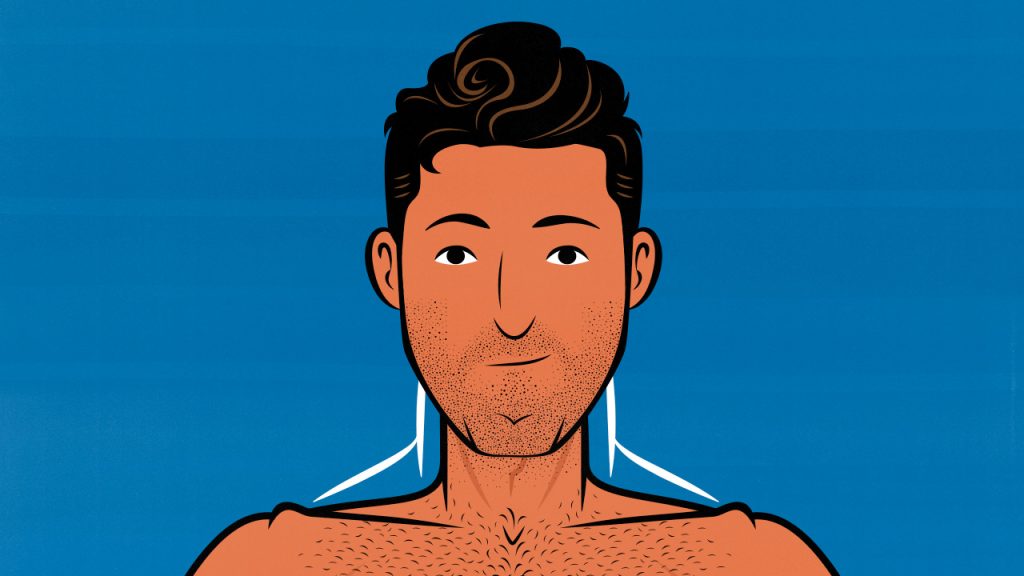
How to Build a Thicker Neck (Even if It’s Skinny)
I always hated how skinny my neck was. When I was at my skinniest, my neck circumference was 14 inches. After bulking up and gaining 60 pounds, it grew to 14.25 inches. Clearly, the compound lifts I was doing weren’t developing my neck muscles.
That’s where neck training comes in. Neck training isn’t common with bodybuilders, strongmen, or powerlifters, but it has a long history in contact sports and martial arts, given that it reduces the risk of concussions, knockouts, and brain trauma. That’s Marco’s area of expertise. Before founding Bony to Beastly, he was training college, professional, and Olympic football and rugby players.
Still, I was skeptical about how effective a neck workout routine could be. That skepticism didn’t last. With just a few months of doing 5-minute neck workouts, my neck grew from 14.25 to 16 inches. We’ve reproduced those results with several dozen clients. We’ll show you exactly how to do it.
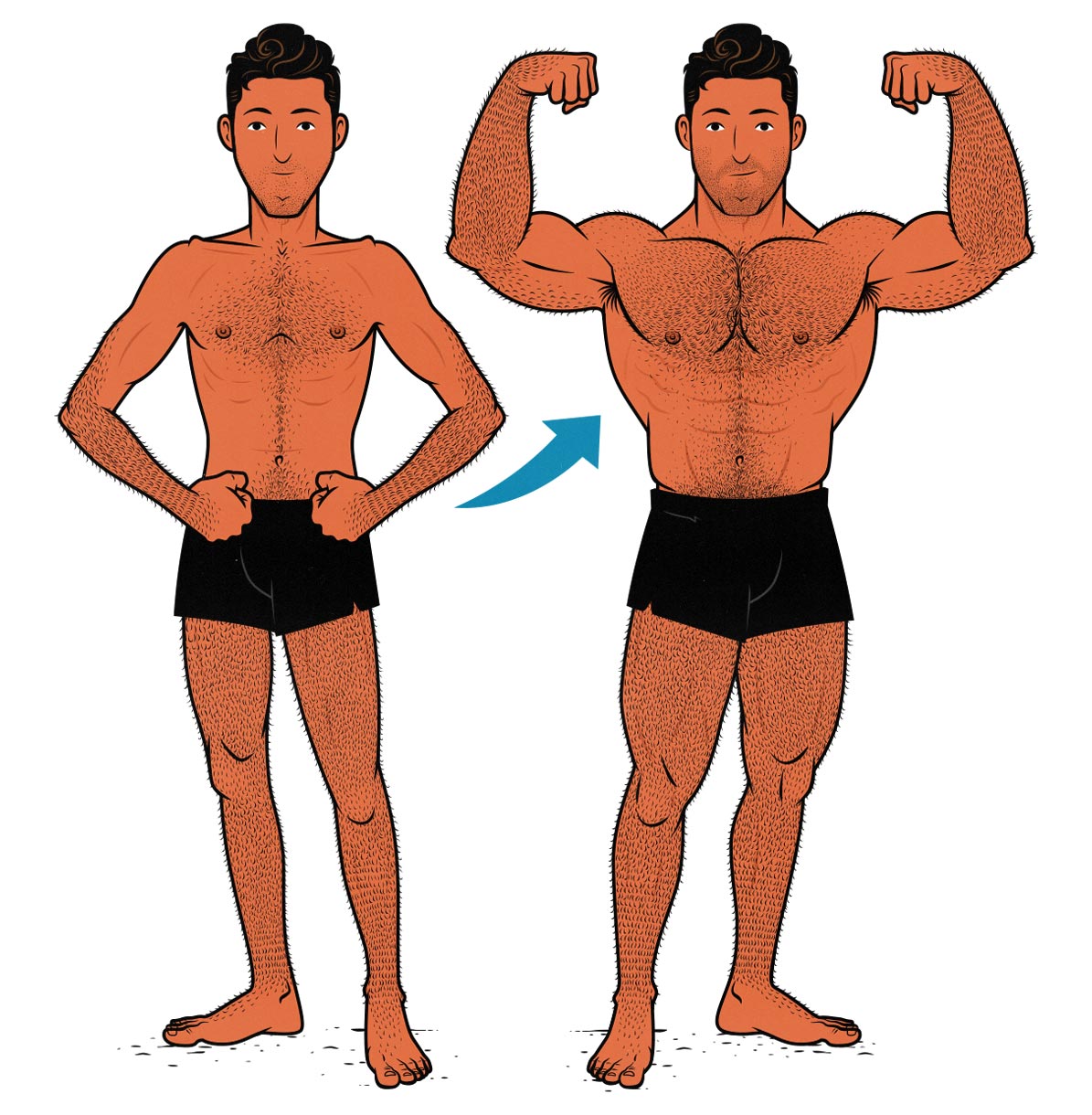
The Minimalist Neck Workout (Tutorial Video)
Maximalist neck workouts can be a hassle. Most people don’t want to do 4 sets of 4 different neck exercises 3 days per week. But you don’t need to do every neck exercise. In fact, you only need to do one. That’s what I did.
Here’s the minimalist neck workout I used to bulk up my neck. It’s just one exercise. You don’t need to do any warm-ups. You don’t need any special equipment. You could even do it at home.
Here’s the workout routine:
- Superset: neck curls + twists + nods (as shown in the video).
- 25–35 reps of curls to failure + 10–20 twists + nods to failure.
- 3 of those supersets per workout.
- 3 workouts per week.
- Add resistance by pressing against your forehead or using a weight plate.
I did it while playing hide-and-seek with my 5-year-old. I’d do 30 reps with my eyes closed, counting out the reps while he hid. We’d play 3–4 games a few times per week. That was enough to add almost 2 inches to my neck within just a few months. If that sounds too complicated, I think you’d get similar results if you skipped the hide-and-seek part.
You probably have questions. Let’s dive deeper.
My Neck Bulking Results
Before we talk about how to build a thicker neck, let me show you my own results. I gained 55 pounds during my first two years of serious bulking. That was enough to completely hide my skinny neck:
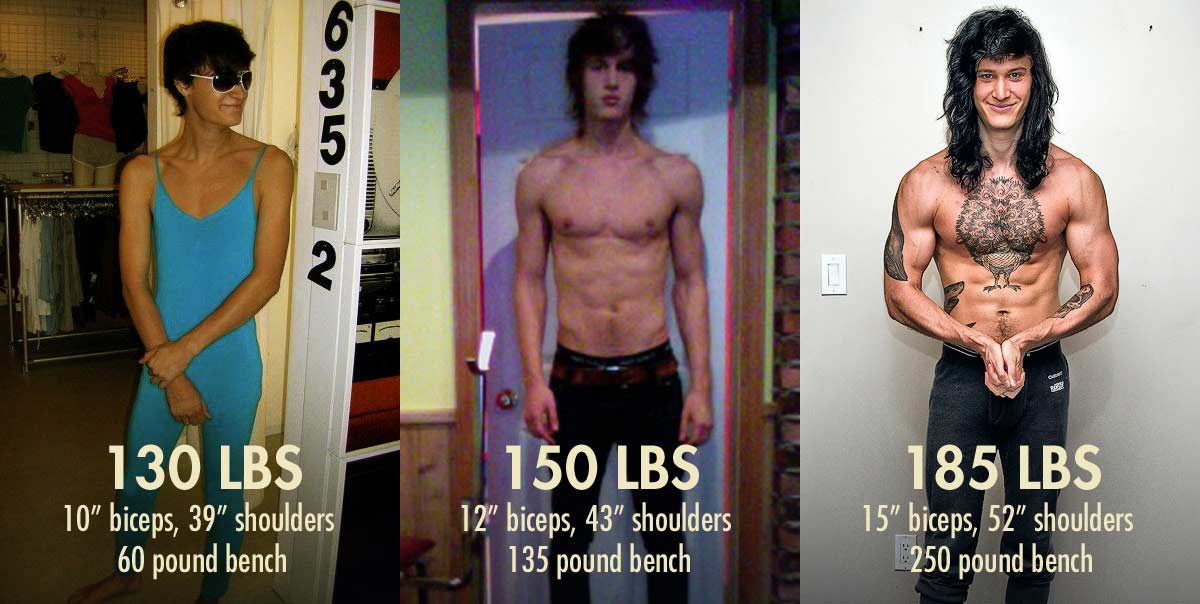
Underneath the hair, though, my situation was grim. After gaining 55 pounds, adding 13 inches to my shoulder circumference, and gaining 5 inches around my biceps, my neck had only grown 0.25 inches, going from 14 inches to 14.25 inches. And because my other muscles had grown so much more, my neck suddenly looked disproportionately small.
The odd thing was, in photos where you could see my whole body, I looked pleasantly muscular, but then in photos of just my head, I looked as skinny as ever. It looked like my head was connected to the wrong body.
So I started training my neck:

These before and after photos were taken 3 months apart and show my neck circumference going from 14.25 inches to 16 inches. I have candid photos showing the change, too. Here are some family photos taken before and after my neck transformation:

In retrospect, the reason my neck lagged is obvious: I never trained it. It’s like never training your chest and then wondering why your chest isn’t growing. But neither bodybuilders nor powerlifters train their necks, so I had assumed it must be dangerous or unnecessary.
I also never trained my jaw muscles. Most people don’t. So, I’ve started training those as well.
Should You Build a Bigger Neck?
Are Neck Workouts Safe?
Neck training is safe when it’s done correctly. We have neck muscles for a reason. We’re supposed to be able to move our necks around. Our necks are supposed to be strong. And there’s a long tradition of boxers, wrestlers, football players, and rugby players building fearsomely strong necks without any issues.
You might think that neck training is like rounding your back when deadlifting. But deadlifts involve maximal loads. Neck training is far more similar to flexing your spine when doing crunches, which is quite safe, even when doing hundreds of repetitions every day for an entire lifetime.
As we mentioned above, Marco used to train professional football players and Olympic rugby players. They trained their necks to reduce their risk of injury. The stronger they could make their neck muscles, the sturdier their necks would be, preventing breaks and concussions.
But just to be sure, I confirmed that neck training was safe with Greg Nuckols, MA, who runs the top research review, Monthly Applications in Strength Sport. He, too, had no issues whatsoever with neck training—as long as it’s done properly.
Range of Motion Concerns
The joints in your neck are designed to move through a small range of motion. The joints in your neck aren’t like your shoulder, knee, or elbow joints. Your spine is made up of a series of small joints, each with a relatively small range of motion. They’re strongest and sturdiest in the middle of that range of motion.
If you watch the tutorial video at the beginning of the article, I show you how to work your neck through a fairly small range of motion while still working your neck muscles at long muscle lengths. I do this by keeping my neck “packed” (aka making a double chin). It’s super safe, great for neck mobility and posture, and fantastic for building muscle.
It’s also possible to train your neck like you train your spinal erectors: with isometrics. When you deadlift, you barely move your spine, but it still grows stronger from supporting the heavy loads you’re lifting. You can take the same approach with your neck. Instead of lifting and lowering a weight, you could hold it in place, letting your neck muscles fight to maintain proper posture.
Neck Size & Sleep Apnea
The risk of sleep apnea starts to increase at a neck circumference of 17 inches. That stat comes from a study published in the European Respiratory Journal (study). A second study confirmed that finding (study). But it’s not quite that simple. Most people have oversized necks because they’re overweight, not because they have muscular necks.
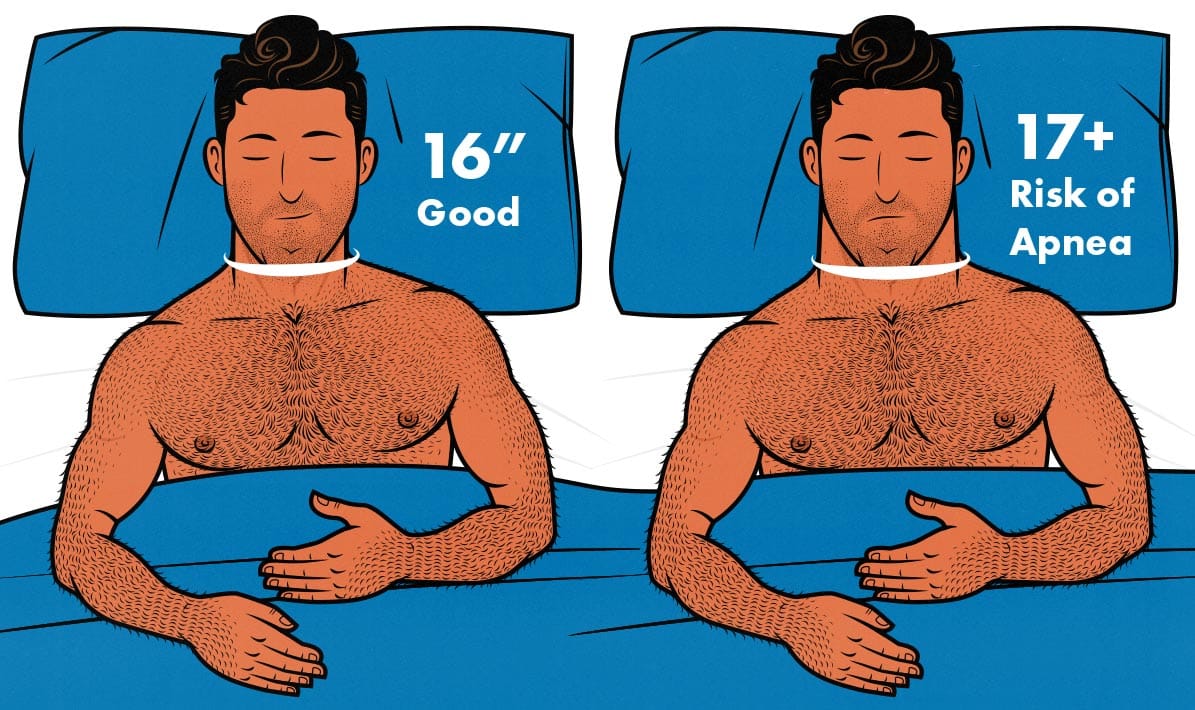
Dr Brandon Peters, MD, a sleep medicine specialist, wrote that sleep apnea might be caused by fat in and around the neck, not simply having a thicker neck.
First, as an individual becomes more overweight or obese, one area of the body that becomes larger in circumference is the neck. Therefore, a large neck likely corresponds to increased fat tissue elsewhere in the body, including at the base of the tongue and lining the airway. Aside from having a large stomach, there will also be tissue crowding along the airway, especially in the throat.
–Dr Brandon Peters, MD
We get the same hypothesis from the Mayo Clinic:
In most people, a neck size greater than 16 or 17 inches is a sign of excess fat in the neck area. This may contribute to crowding and narrowing of your breathing tube, making obstruction or blockage of your airway while you sleep all the more likely.
–The Mayo Clinic
There seems to be a consensus that sleep apnea is linked to neck fat, not neck muscle. However, it might still be prudent not to push it. Some thick-necked fighters do suffer from sleep apnea, even though their necks are lean. Given how important sleep is, I’m not eager to become a guinea pig.
If you keep your neck under 17 inches, you should be fine. 16 inches seems like a good size for me, so no issue there.
Neck Aesthetics
What’s the Average Neck Size?
Most men have necks between 15 and 16.5 inches. According to a study published in the Journal of Diabetes Research, the mean neck circumference for a man is 16.5 inches. Some other studies measured the average male neck size at 15 inches.
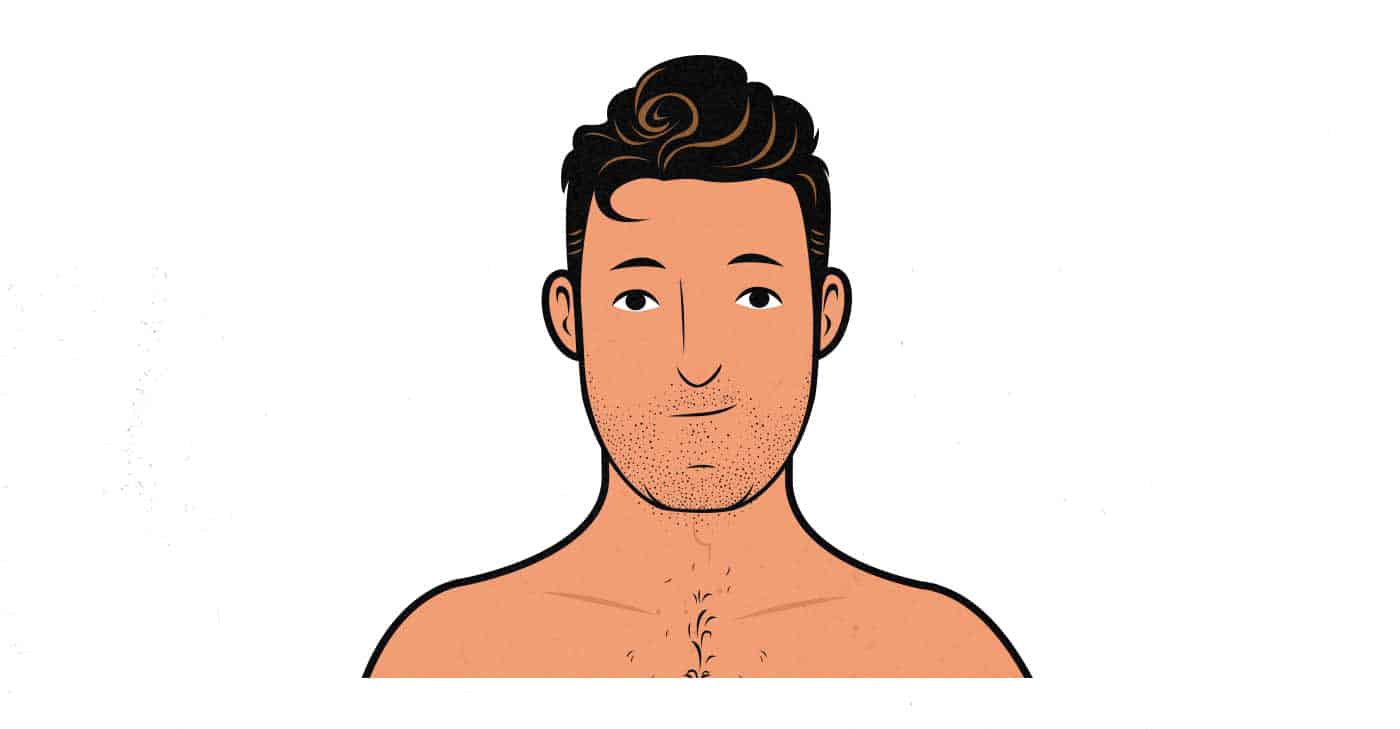
When I first saw that, I thought of my own 14-inch neck and felt disheartened. Even after gaining 60 pounds and getting up to a healthy body weight, my neck was still 2 inches smaller than the average sedentary man. Mind you, the average man’s neck is thicker because he has a higher body fat percentage, not because his neck is more muscular.
(To make matters trickier, the best way of estimating your body fat percentage at home is the Navy Method, which takes into account your neck size. Neck size is used as a proxy for muscle mass, so if you have a naturally thin neck, it will underestimate your muscularity and overestimate your body fat. You can fix that by making your neck as strong as the rest of you.)
The Average Neck Size of Skinny Guys
In our bulking program, we guide skinny guys through the bulking process. We wrote an article covering their average bulking results. We also have their average neck measurements. The average naturally thin guy has a neck size of 14.4 inches.
That means we need to gain 1–2 inches to get up the average neck size. You can probably do that within a few months. Most guys doing our program don’t train their necks, but those who do gain around 1.5–2 inches after 6 months.
The Most Aesthetic Neck Size
Dr. Casey Butt, Ph.D., is famous for studying bodybuilding aesthetics. He compared the measurements and proportions of all the “silver era” bodybuilders from the 1940s–60s, back when bodybuilders were still natural.
Dr. Butt thought the ideal neck size was the same as the ideal arm size: 50% of your waist circumference. It’s a little bit more complicated than that. The average American man has a few extra inches of fat around his waist. The average skinny guy can often benefit from adding a few inches of muscle to his abs, obliques, and spinal erects. That means for most men, the “ideal” waist circumference is somewhere in the neighbourhood of 30–34 inches, putting their ideal neck size at around 15–17 inches.
- Ideal waist size: a strong waist at 8–15% body fat.
- Ideal arm size: waist × 0.5
- Ideal neck size: waist × 0.5
This heuristic is good for bodybuilding, and I think it works okay for the average guy. I have a 32-inch waist, 16-inch arms, and a 16-inch neck. I like how that looks and feels. It worked for me. But I don’t think it’s the right way to think about aesthetics. I prefer the approach we outline here.
The Most Attractive Neck Size
I spoke with Dr. Aaron Sell, the lead researcher on one of my favourite attractiveness studies. His research shows that the stronger and more formidable we appear (especially in our upper bodies), the more attractive we look.

Here’s a really good example from someone who did our bulking program (a couple of times over several years). Sean gained just over 20 pounds, bulking up his neck along with the rest of his muscles. The impression he gives off has totally changed. He looks stronger, tougher, and more “formidable.”
Neck size is a huge predictor of formidability. Think of how essential neck strength is when fighting. You’d expect it to be strongly linked with attractiveness. But since neck size hasn’t been studied in isolation from overall muscularity, we couldn’t be sure, let alone put a specific number to it.
So, to figure out the most attractive neck size, we surveyed over 500 people, asking them to rate different neck sizes (survey breakdown here and here). Our results were somewhat at odds with Dr. Sell’s research. The most formidable “fighter” neck didn’t fare very well, with only 5% of women and 14% of men preferring it. Most people think a neck size of 15–17 inches looks best.
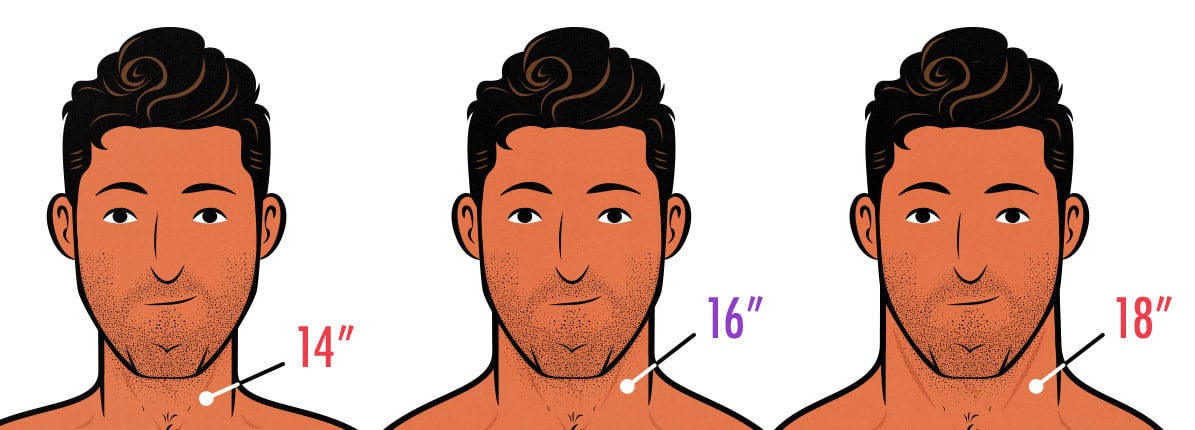
This is really good news. A 16-inch neck is easy to build, isn’t associated with sleep apnea, and is still plenty strong and athletic. You can build a 16-inch neck with just a few months of smart training.
How to Build A Thicker Neck
Neck Muscle Anatomy
Your neck is packed full of muscles that help you flex, extend, twist, and turn your head. We’ll show you how to bulk up all of them. It isn’t as complicated as it seems.
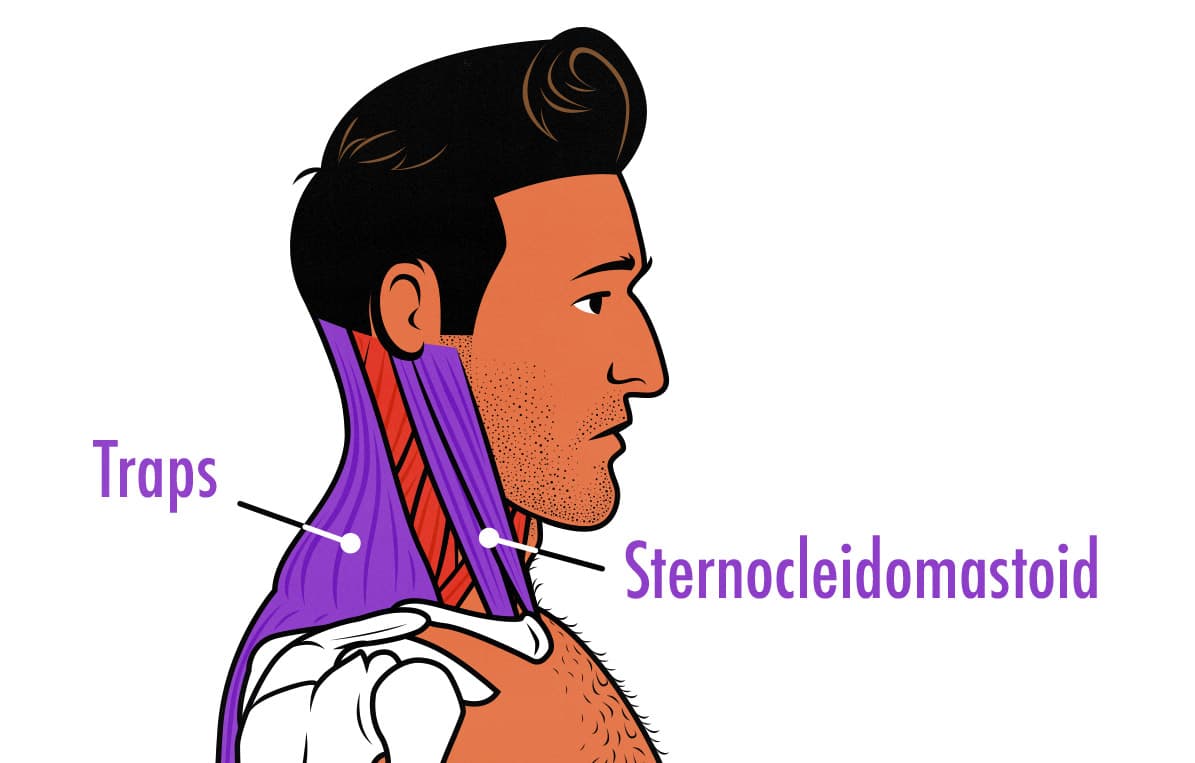
Most of your results will come from bulking up your upper traps and sternocleidomastoid. We’ll focus on those, but we haven’t forgotten the others. We’ll train them, too.
Your upper traps are your biggest neck muscle. They help to stabilize your shoulder girdle, so you can bulk them up with deadlifts, loaded carries, overhead presses, and even lateral raises. If you follow a good workout program, they should grow in proportion with the rest of your muscles.
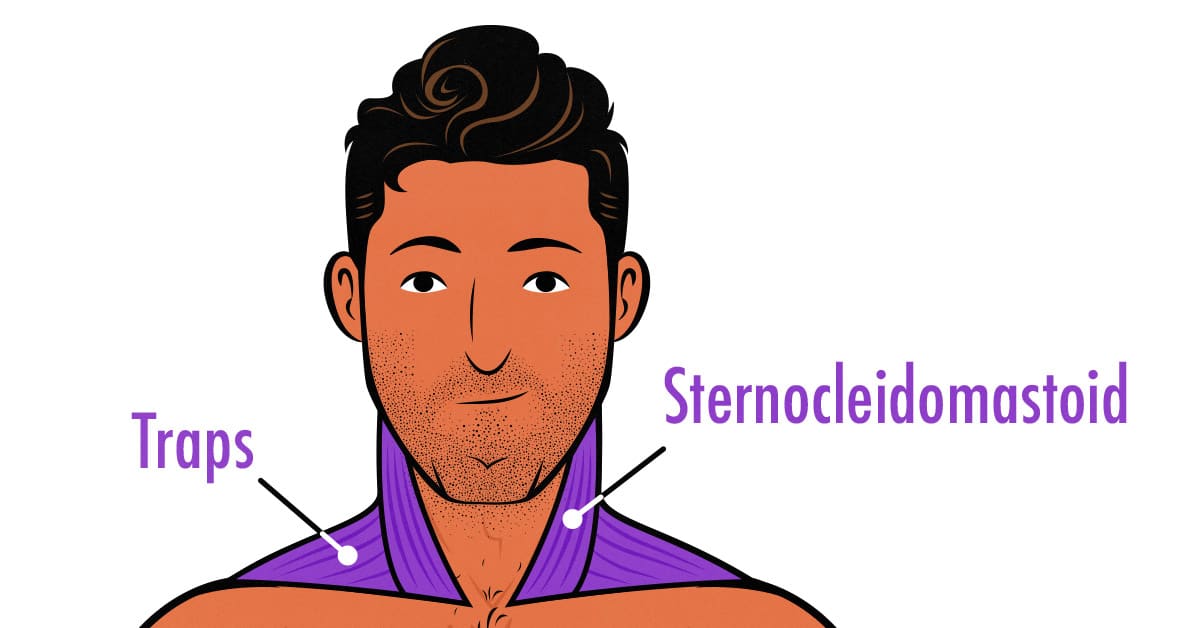
Your sternocleidomastoid is the muscle that will make your neck thicker. It’s a bit of a tricky muscle. It pulls your head towards your collarbones but tilts your head backwards. That’s why I like to keep my neck “packed” while doing neck curls. “Pack your neck” is a common lifting cue, especially with compound lifts like overhead presses and deadlifts. It also helps here.
Packing your neck while doing neck exercises lengthens the sternocleidomastoid at the back, training it under a deeper stretch. Training at long muscle lengths is better for building muscle (full explanation). Plus, packing your neck keeps your spine in a more neutral position, which (anecdotally) seems to be good for preventing minor neck aches and strains.
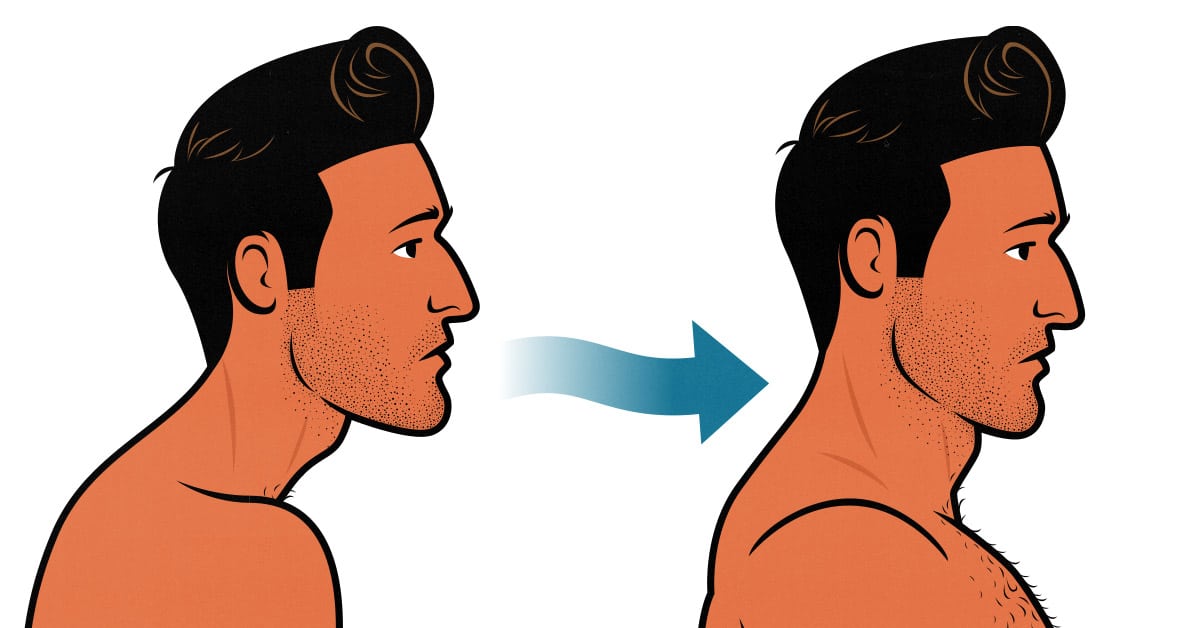
Many other smaller neck muscles will fight to keep your chin tucked. They’ll grow bigger and stronger, too. They aren’t as big as your sternocleidomastoid and won’t add as much girth to your neck, but I suspect they help improve neck posture.
The 3 Best Neck Exercises
You can build bigger traps with deadlifts, overhead presses, lateral raises, and loaded carries. If you follow a balanced bulking program, your traps will grow just fine. They don’t usually need any special attention. If they do, you can add in some shrugs.
Your other neck muscles do need special attention, so let’s dive deeper into the best neck exercises.
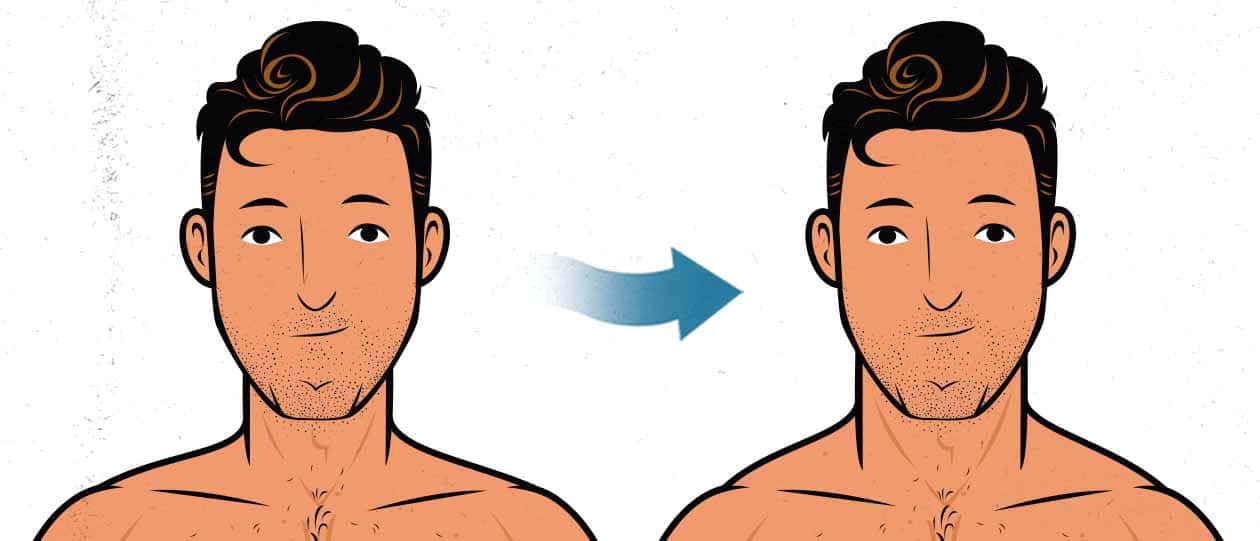
The Neck Curl
The neck is arguably the best exercise for building a bigger neck. It’s best at bulking up your sternocleidomastoid, but it also engages many of your smaller neck muscles.
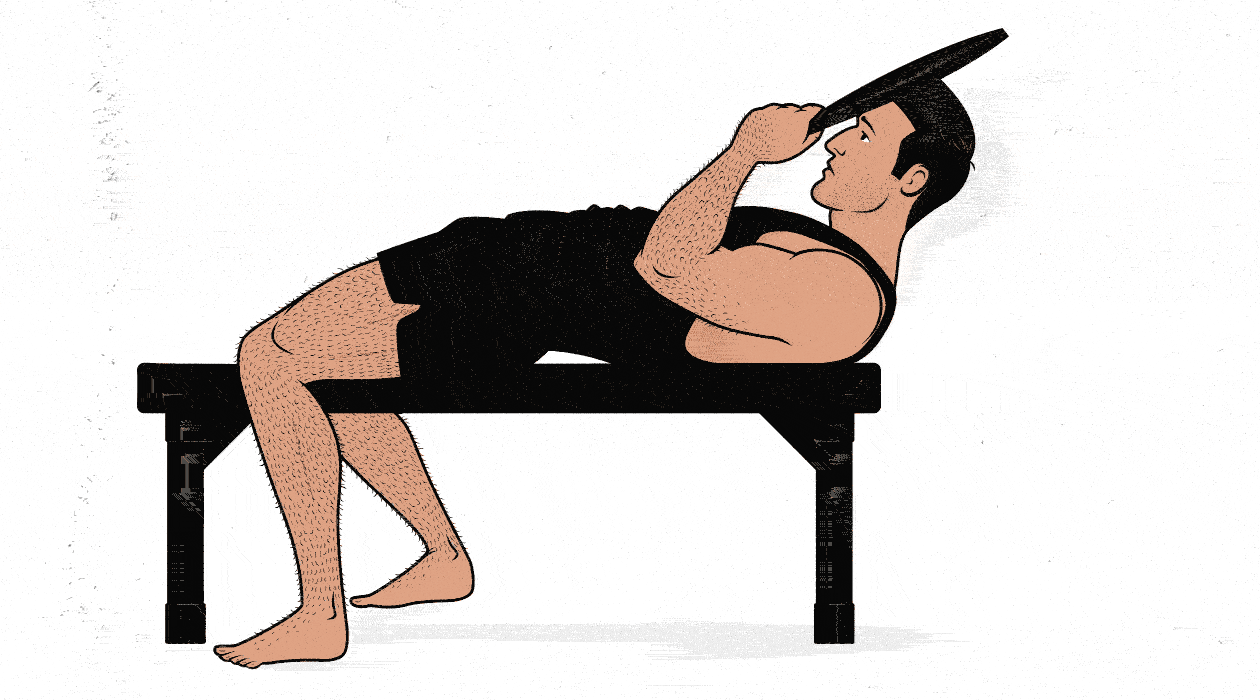
You can do these with weight plates or by pressing your hands against your forehead. I show both variations in the tutorial video at the beginning of the article. Both approaches can work. I started with weight plates and then switched over to pressing with my hands. Using my hands was easier and seemed to be just as effective.
The Neck Extension
Neck extensions train your upper traps and spinal erectors, bulking up the back of your neck. Those muscles get some work from your compound lifts. You don’t need to isolate them. But you certainly can.
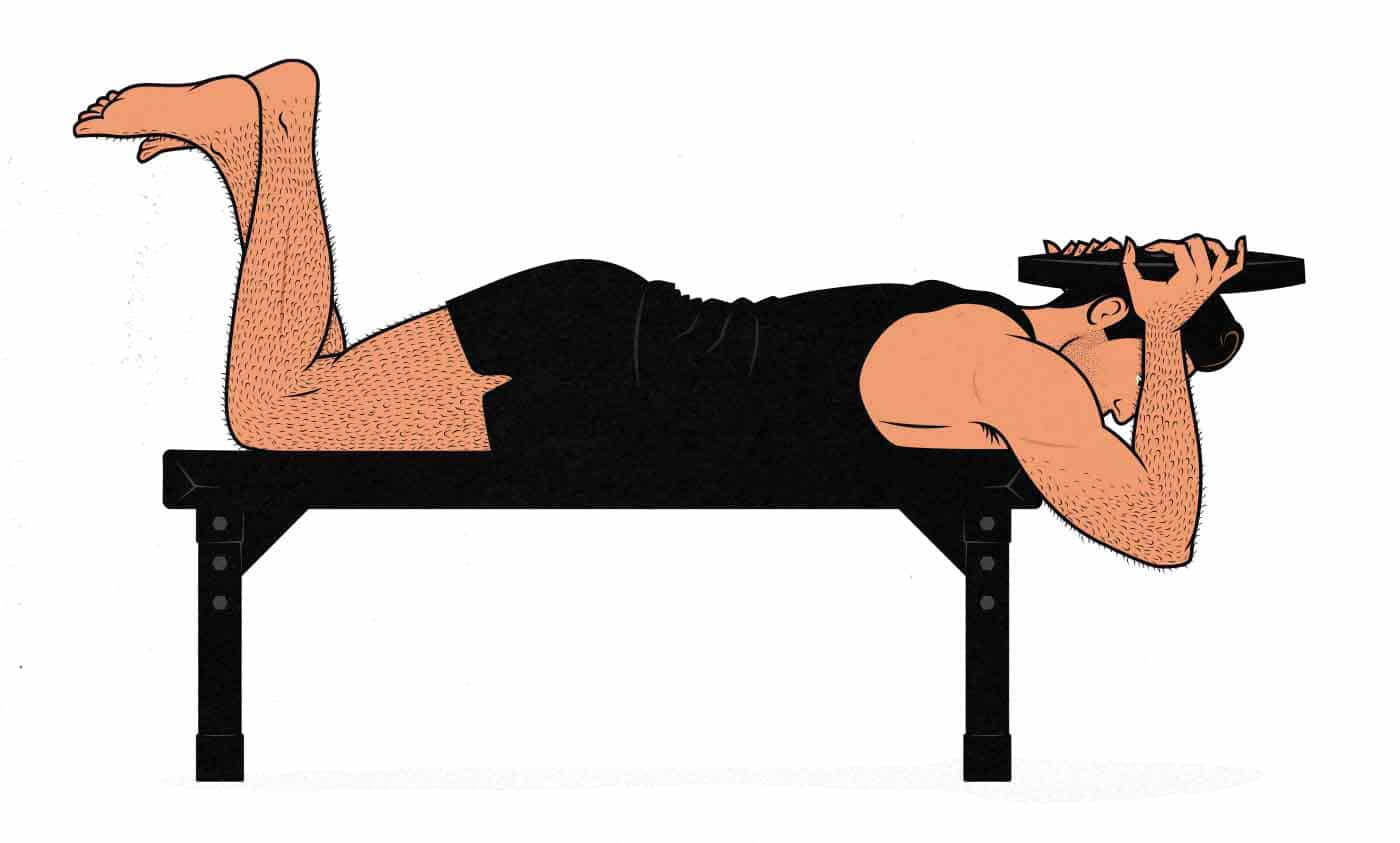
The simplest way to do neck extensions is to put a plate on the back of your head and then extend it backwards. It’s the same technique as with neck curls, just in reverse. It’s an awkward movement, though, so most people do neck bridges or get a neck harness instead.
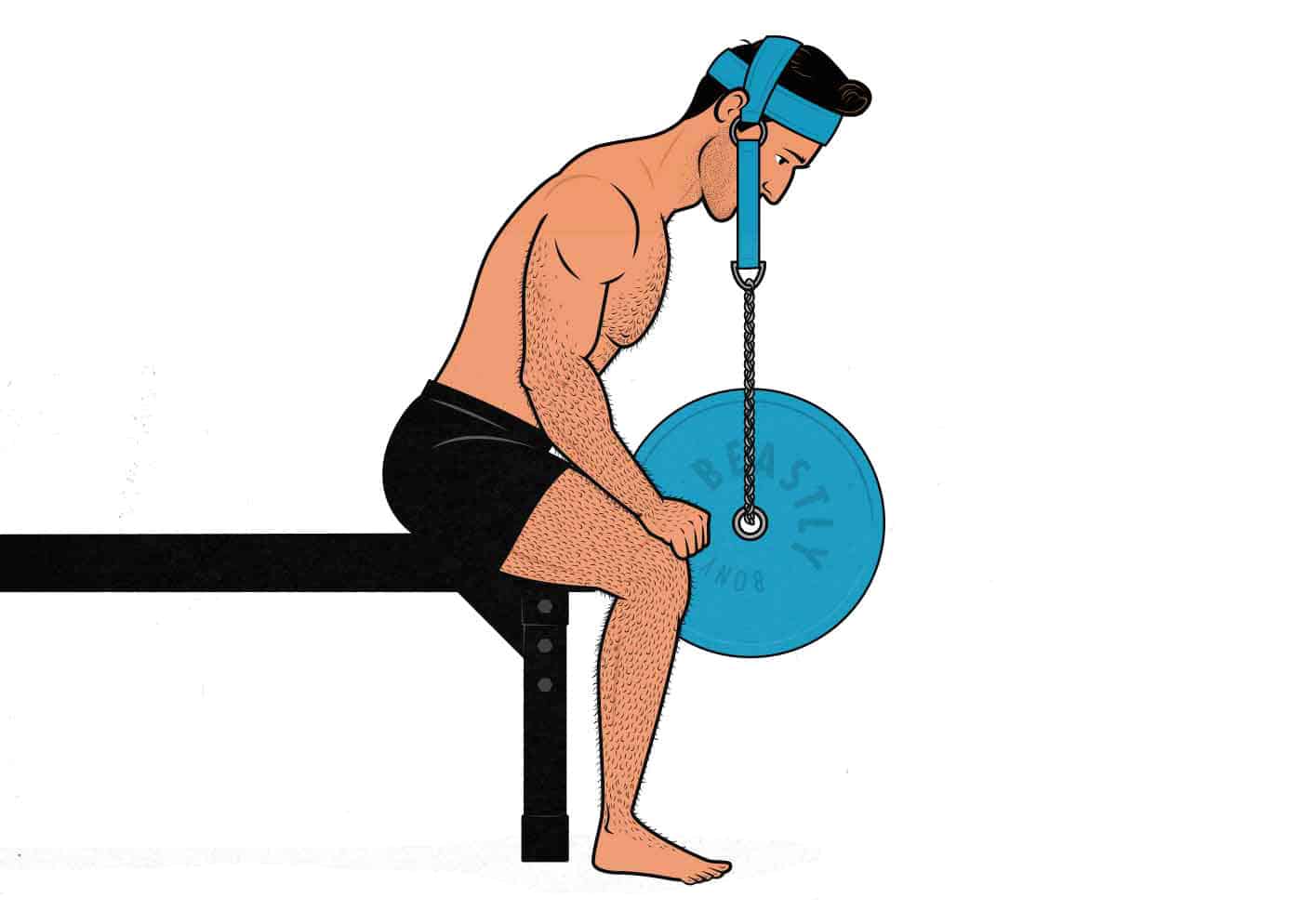
I tested a couple of neck harnesses over several weeks. Iron Neck makes a good one. I didn’t wind up needing it, though. I didn’t do any neck extensions.
Neck Side Raises
Neck side raises train your sternocleidomastoid and a bunch of other smaller neck muscles. It’s a simple exercise. Lie somewhat awkwardly on the bench and flex your neck sideways. Again, any resistance will work (including your hands). I didn’t do these, but I think I might start.
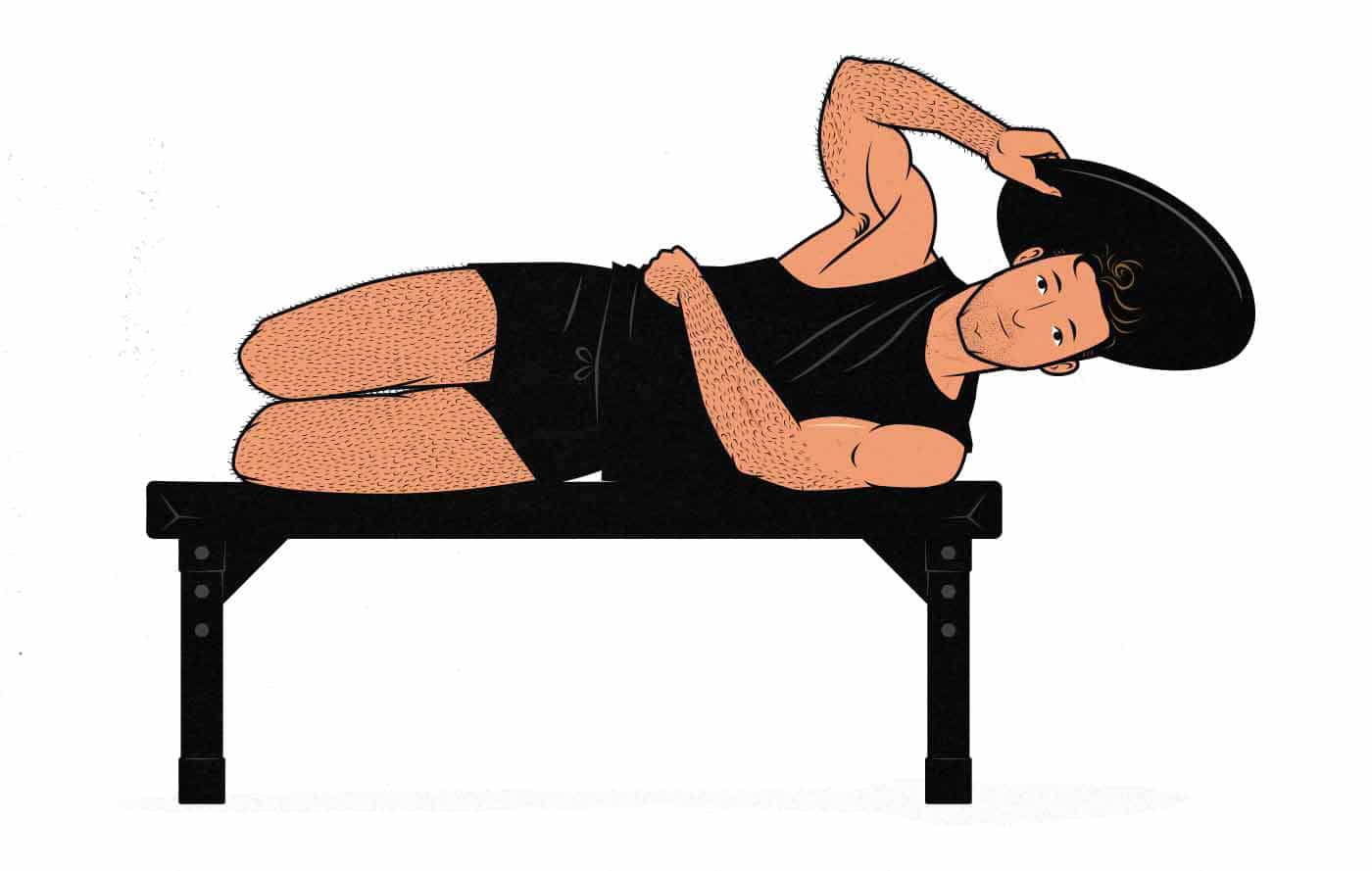
Neck side raises aren’t needed, but they’re a nice way to increase our neck training volume without needing to do endless sets of neck curls. They might also help you build more symmetrical neck muscles.
Ease In But Dig Deep
Start with just 2 sets per exercise. The first time the muscles in your throat get sore, it feels similar to having a sore throat, and you may fear you’ve gotten sick. The harder you train in those first workouts, the more crippling that soreness can be. Better to ease into it. I recommend starting with two sets per neck exercise and stopping a good 2–3 reps shy of failure. That will keep the soreness manageable.
As your neck grows thicker, stronger, and tougher, you can gradually add sets and start training closer to failure. A few weeks from now, you can do as many as 4–5 sets of neck curls per workout, doing them 2–4 times per week.
What surprised me the most was that neck training started to feel really good once I got used to it. My neck has started to feel noticeably sturdier and tougher. The training has become hearty and strenuous. I’ve come to enjoy it. It wasn’t what I expected.
Warm-Ups and Neck Stiffness
It’s normal for a muscle to feel sore and stiff after training it, especially during the first week or two of following a new workout program. When that stiffness is in your neck, it can feel more threatening. The best way to avoid excessive soreness is to ease into your neck training. Don’t go all-out in your very first workout. Start with just 2 sets and gradually work your way up.
Some people say that doing neck warm-ups helps. I prefer to do high-rep sets. That way, the first dozen reps serve as a warm-up for the last dozen reps. But you can warm up your neck if you want to.
Sets, Reps & Training Frequency
You can train your neck 2–4 times per week with 2–5 sets per workout. Most research shows you can maximize growth by training your muscles twice per week.
At the peak of my neck training, I did 3–4 sets of neck curls. Each set was supersetted with twists and nods. I did all 3 exercises in a row, rested for a minute, and then did the next superset. The full workout only took around 5 minutes. If you do that 3x per week, that’s 27–36 sets for your neck muscles per week. That’s a high training volume. Your neck will grow quite fast.
Aim for 25–35 reps per set. Most research shows that we build muscle the most efficiently when we do 6–20 reps per set. But since these are smaller isolation lifts that we’re doing, going even higher can work incredibly well. That also saves you from needing warm-up sets, keeping your workouts shorter.
Short rest periods are fine. Because your neck muscles are relatively small, you can do high-rep sets with short rest times without your cardiorespiratory system limiting you. You’ll lose reps from set to set, but that’s okay.
Avoiding Bruises & Neck Pain
Don’t press weights into your forehead. I recommend padding your forehead with a bandana or towel to prevent the plates from giving you bruises or calluses. A patch of thicker callused skin on your forehead would pull attention away from your impressively muscular neck. Better to avoid it.
Neck strains are called “zingers.” Apparently, it’s common for people to strain their neck muscles by jerking the weight around. I never had that issue. I think lifting in a higher rep range with a more modest range of motion saved me.
Measuring Your Neck
If what you’re doing isn’t working, no amount of patience or persistence will yield results. Results only come from the accumulation of gradual progress. So, you need to measure your progress to make sure it’s gradually accumulating.
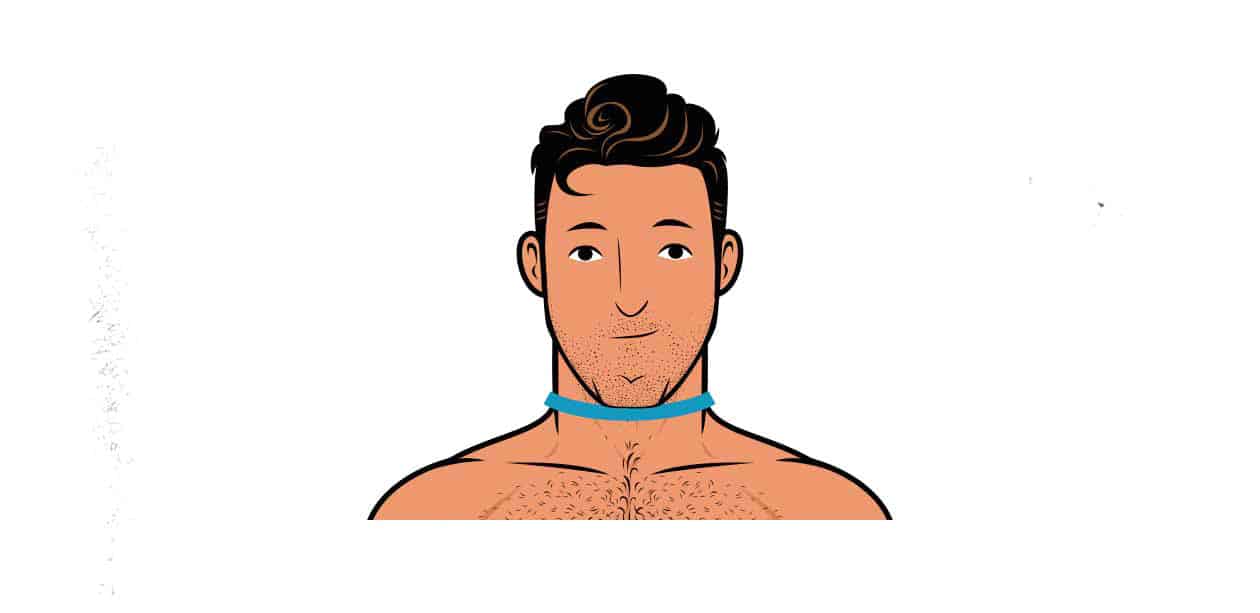
Since your goal is to build a thicker neck, you can measure your neck circumference. I recommend measuring your neck right above your traps, right where the collar of your shirt would be (though I don’t recommend wearing shirts).
Tracking Progress
Track your weight/reps/sets, and always try to improve. To gain muscle size, you need to focus on getting stronger. You need to fight to add weight or eke out more reps. Your neck muscles have good potential for growth and can grow surprisingly strong. You might surprise yourself with how quickly you can improve.
Use a wide rep range if you need to. It’s often best to add 2.5–5 pounds whenever you reach the top of your target rep range (35 repetitions). But if you’re using a weight plate, you might only be able to go up in increments of 5 or even 10 pounds. In that case, be flexible with your rep range. Anywhere from 20–40 reps is great.
Finally, make sure you gain at least a little weight on the scale each week. If you’re skinny-fat or overweight, you can recomp. But if you’re skinny, you’ll need to bulk—you’ll need to eat enough calories to gain weight. That’s the only way to fuel muscle growth.
Frequently Asked Questions
What Exercises Work Your Neck?
None of the big compound lifts stimulate the muscles in your neck. That’s why until people start training their necks directly, their necks don’t grow.
The only exception is that some lifts—such as deadlifts, shrugs, overhead presses, and lateral raises—train the traps. Building bigger traps will make your upper body look more muscular, but it won’t make your neck any thicker.
The best exercises for your neck are isolation exercises:
- Neck curls
- Neck extensions
- Neck bridges
- Neck planks
- Neck side raises
Of these exercises, neck curls are the most important.
Why Don’t Modern Bodybuilders Train Their Necks?
If you look at natural bodybuilders, you’ll notice that many have fairly skinny necks. I was curious about this. Bodybuilders care a great deal about aesthetics, and building a more muscular neck is one of the best things you can do for aesthetics.
I asked Dr. Eric Helms why bodybuilders don’t train their necks. Helms is a muscle hypertrophy researcher as well as a competitive natural bodybuilder. If anyone knew, he would. He explained that the biggest professional bodybuilders develop thick necks simply from their PED abuse. Their entire bodies bulk up, including their faces, necks—everything. If they add neck training on top of that, they risk building such thick necks that it restricts airflow (as we’ve discussed above).
That isn’t a problem for natural bodybuilders (like Dr. Helms), but he explained that the judging criteria of bodybuilding flow down from the professional bodybuilders. If they aren’t bulking their necks, the natural guys don’t do it either. Neck training isn’t part of their culture.
Finally, many bodybuilders are naturally muscular, with naturally thicker necks. Some have histories of playing college football or wrestling. They already have thick necks. They don’t need extra neck exercises.
Will Deadlifts Make Your Neck Bigger?
Deadlifts train your traps, which are technically part of your neck. Taller traps won’t make your neck any thicker, though. For that, you’d need to bulk up your sternocleidomastoid muscles.
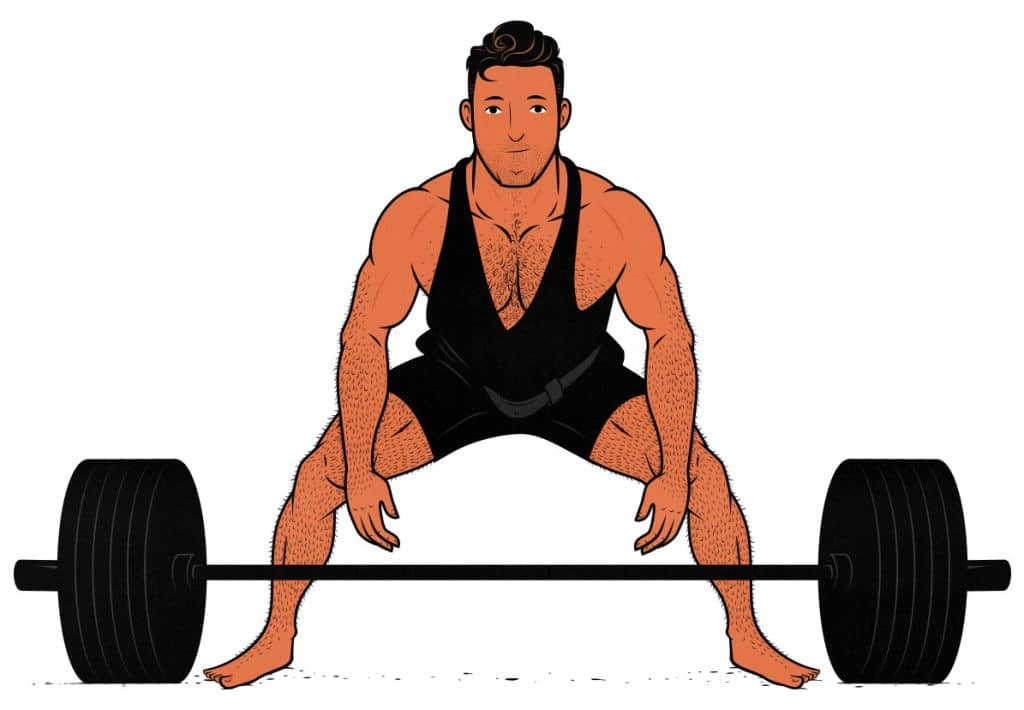
Some guys build bigger sternocleidomastoid muscles from deadlifts. Omar Isuf is a good example of that. He gained several inches around his neck from subconsciously flexing it while deadlifting. That’s fairly rare.
Will Your Neck Shrink if You Stop Training It?
Many former football players, boxers, and martial artists maintain muscular necks decades after they stop training them. A popular example is the actor Channing Tatum, who built a bigger neck while doing martial arts and playing football in college. He stopped training his neck for 20 years, yet it’s still his most developed muscle.
That’s strange. Some of the changes in our muscles are permanent, but almost everyone loses at least some muscle size when they stop training their muscles. You might maintain some of your neck gains, and that might be enough to give you a pleasantly muscular neck, but you probably won’t maintain peak neck size unless you do a couple of sets of neck curls per week.
I bulked my neck from 14.25 to 16 inches, then stopped training it for 2 years. It shrunk back down to 15.25 inches and stayed that way. Then I bulked it back up again.
How Can You Train Your Neck at Home?
I bulked up my neck at home with bodyweight exercises. The most popular bodyweight exercises are neck bridges. They’re popular with fighters. But I recommend neck curls instead. I show the body weight variation in the tutorial video at the beginning of the article.
Are Neck Workouts Bad for You?
No, there’s no reason to think that neck workouts are dangerous. They do train the spine, and it’s wise to be careful when training your spine. However, neck exercises tend to be relatively light, especially compared to other exercises that load the spine, such as the deadlift. Because of the lighter loads you’re using, there’s far less shear stress on your spine. It isn’t an issue.
Plus, neck training has several benefits, including increased resilience to concussions and traumatic brain injuries, such as those you might get in a fight or car crash. That’s why neck training is ubiquitous in combat sports like boxing, MMA, and football.
Do Shrugs Train the Neck?
Shrugs train the upper traps, and your traps do connect to your neck. But building bigger traps won’t make your neck any thicker. To build a thicker neck, you need to train your sternocleidomastoid. The best way to do that is with neck curls.
Conclusion
I recommend bulking up your traps by following a good bulking program. Deadlifts, overhead, presses, and lateral raises will do the trick.
Then, for your sternocleidomastoid, I recommend neck curls, twists, and nods (as shown in the tutorial video at the beginning). You can add neck extensions, bridges, and/or side raises if you want a more robust neck routine. Sets of 25–35 reps tend to work best, but anywhere from 20–40 reps can work well.
Train your neck 2–4 times per week with 2–5 sets per movement, aiming for at least 9 sets per week. I wanted to bulk my neck up faster, so I did 27 sets per week. Mind you, the exercises were supersetted together. It only took me around 15 minutes per week.
It’s common for people to gain an inch or two in neck circumference within just their first few months of training. 16 inches seems to be the sweet spot for most people.
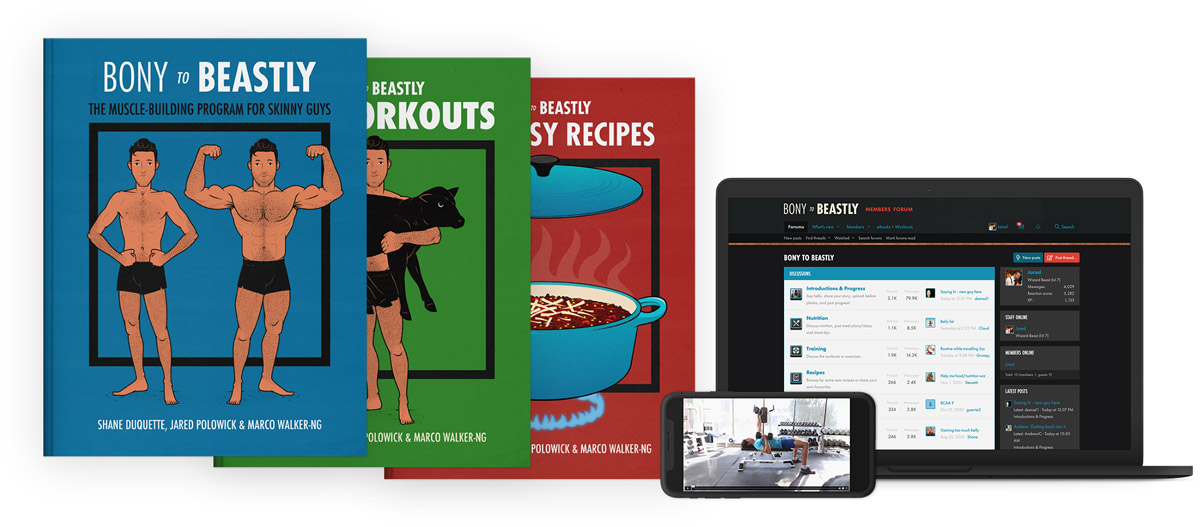
Alright, that’s it for now. If you want more muscle-building information, we have a free muscle-building newsletter. If you want a full workout and diet program, including a 6-month customizable full-body workout routine, diet guide, recipe book, and online coaching, check out our Bony to Beastly Program. Or, if you want a customizable intermediate muscle-building program, check out our Outlift Program.

